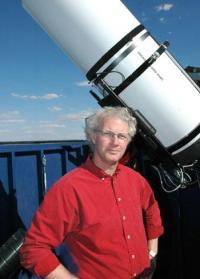As the 100th anniversary of the June 30, 1908 event approaches, astronomy enthusiast Robert Holmes Jr. of Charleston has been using his two professional-grade telescopes to measure potentially hazardous objects that could collide with the Earth.

|
| ©JG/T-C |
| Astronomy enthusiast Robert Holmes Jr. of Charleston has been using his two professional-grade telescopes to measure potentially hazardous objects that could collide with the Earth. |
Eastern Illinois University physics professor James Conwell and Holmes have partnered to turn over images collected via the two telescopes to students throughout the world for analysis as part of NASA's Near-Earth Object Program.
Holmes estimated his observatory near Charleston has facilitated the measuring of 5,835 near-earth asteroids during the past year.
"The asteroid or comet that exploded over Tunguska (in Siberia) is very small and we don't typically research objects this small with our telescopes," Holmes said. "We measure asteroids that are 10 times this size, or about 400 feet in diameter or larger."
Holmes said there are 5,515 known near-Earth objects and 743 of these are listed as potentially hazardous asteroids by NASA's Jet Propulsion Laboratory.
As part of his work with NASA, Holmes said he tracks near-Earth objects and reports their positions to the Minor Planet Center at Harvard University's Smithsonian Astrophysical Observatory.
"By doing this research, NASA scientists can determine real impact risks and could alter the orbit of a future impactor so it doesn't strike the Earth," Holmes said.
Holmes said he and Conwell have worked with students from 97 high schools, colleges and universities in nine countries during the past year in association with the Near-Earth Object Program.
One of these students is from the Tunguska region and immigrated to the United States a year ago, Holmes noted.
Conwell said Holmes' two telescopes together can take nearly 2,000 photographs per night of near-Earth objects. He said these images are sent to participating students, who measure the photographed objects and report their findings back to Holmes.
The physics professor said he plans to give a presentation about the Near-Earth Object Program on Monday to public school teachers who are taking the natural science master's program at Eastern. He hopes to recruit them and their students to help.
"(The program) literally shows astronomy is really the last frontier from which amateurs can make a really significant contribution to research," Conwell said.



Reader Comments
to our Newsletter